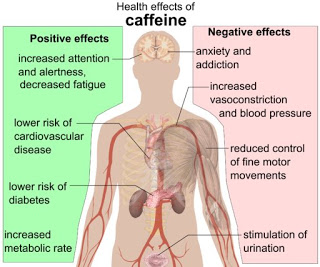Obviously, it's not necessary to know how caffeine works to be
able to use it. It can be helpful in boosting pain relief from other
pain-relievers or by itself. It's especially good for muscle pain relief
- great news if you work out hard.
Scientists speculate that caffeine's pain-relieving power comes from 3 mechanisms:
• It blocks release of adenosine. Adenosine is a brain chemical that carries pain signals to the brain.
• It activates adrenalin pathways in the brain. Those pathways include the body's own pain-killing mechanism.
• It stimulates the central nervous system in a way that changes the processing of pain signals.
Of the 3, I like the first one best. The second 2 don't actually explain clearly (at least to me), but the first does. Here's why.
Adenosine prevents the release of 2 brain chemicals - norepinephrine and dopamine - presumably so the amounts available at a given time are kept within control.
When we consume caffeine, the caffeine blocks adenosine. It occupies the adenosine receptors and prevents adenosine from "getting in." As a result, dopamine and norepinephrine are released in larger amounts. That's why coffee or tea makes us feel alert.
But norepinephrine also has analgesic power, so it offers a bonus - it wakes us up and helps to relieve pain.
Norepinephrine is made when we eat protein foods: fish, eggs, chicken, beef, lamb, pork, turkey, shrimp, crab, yogurt (with 18-22 g of protein per serving).
For non-animal protein, use high-quality vegan protein powders from peas, hemp or other vegetable sources. (I like kale, but it doesn't provide much protein.)
The take-away?
Be sure to eat protein foods regularly, so your norepinephrine stores are adequate when you want to release them by consuming caffeine.
Scientists speculate that caffeine's pain-relieving power comes from 3 mechanisms:
• It blocks release of adenosine. Adenosine is a brain chemical that carries pain signals to the brain.
• It activates adrenalin pathways in the brain. Those pathways include the body's own pain-killing mechanism.
• It stimulates the central nervous system in a way that changes the processing of pain signals.
Of the 3, I like the first one best. The second 2 don't actually explain clearly (at least to me), but the first does. Here's why.
Adenosine prevents the release of 2 brain chemicals - norepinephrine and dopamine - presumably so the amounts available at a given time are kept within control.
When we consume caffeine, the caffeine blocks adenosine. It occupies the adenosine receptors and prevents adenosine from "getting in." As a result, dopamine and norepinephrine are released in larger amounts. That's why coffee or tea makes us feel alert.
But norepinephrine also has analgesic power, so it offers a bonus - it wakes us up and helps to relieve pain.
Norepinephrine is made when we eat protein foods: fish, eggs, chicken, beef, lamb, pork, turkey, shrimp, crab, yogurt (with 18-22 g of protein per serving).
For non-animal protein, use high-quality vegan protein powders from peas, hemp or other vegetable sources. (I like kale, but it doesn't provide much protein.)
The take-away?
Be sure to eat protein foods regularly, so your norepinephrine stores are adequate when you want to release them by consuming caffeine.
For additional tips like these - or for help with health issues - just visit
http://www.FoodAddictionSolutions.com/Coaching and request your free Eating Empowerment Consult. Find out how easy it can be to get your nutrition and your health back on track.
http://www.FoodAddictionSolutions.com/Coaching and request your free Eating Empowerment Consult. Find out how easy it can be to get your nutrition and your health back on track.


Kommentaare ei ole:
Postita kommentaar